Plants from seed at Crocus
by Diane - February 4th, 2013.Filed under: Crocus.
Lovely selection
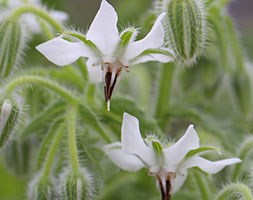
white borage (white borage) £1.99
Position: full sun or light shade Soil: fertile and moist Rate of growth: fast Hardiness: fully hardy The white flowers of this borage make a fresh change to the more traditional blue. The bees will still flock to the nectar-rich blooms, and if picked, the petals can be used to decorate ice bowls and dress soups and salads. The young leaves of this annual have a cucumber-like flavour and can be added to many recipes. They are often used in pasta dishes, while the flowers can be used in ice cubes, salads and even dipped in batter and deep fried. Plant them between your tomatoes to reduce attacks of hornworm. At the end of the year, add the plants to the compost heap as they will promote many beneficial minerals. Borage is an annual plant, but it will self-seed readily in good conditions. If you don’t want more plants, dead-head the flowers as soon as they fade. Garden care: Form shallow drills at 30cm intervals in a well prepared bed, and sow thinly, just covering the seed before watering well. The seeds have a higher germination rate when temperatures are between 15 – 25C, so early sowings can be covered with a cloche. When big enough to handle, thin the seedlings to 25cm. Sow: March – May Flowering: June – September Approximate quantity: 75 seeds.
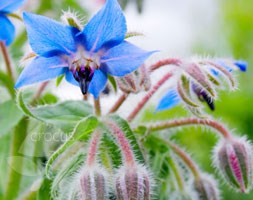
borage (borage – organic) £1.99
Position: full sun or light shade Soil: fertile and moist Rate of growth: fast Hardiness: hardy annual (it will die within one year) A wonderfully useful as well as decorative plant. The young leaves and vivid blue flowers of this annual herb have a fresh cucumber-like flavour, so are often used in salads, soups, chilled drinks or simply as a garnish. The flowers attract bees and other beneficial insects, while the foliage has been known to reduce attacks of hornworm when planted between tomato plants. At the end of the year, add the plants to the compost heap as they will promote many beneficial minerals. Borage is an annual plant, but it will self-seed readily in good conditions. If you don’t want more plants, dead-head the flowers as soon as they fade. Garden care: Form shallow drills at 30cm intervals in a well prepared bed, and sow thinly, just covering the seed before watering well. The seeds have a higher germination rate when temperatures are between 15 – 25C, so early sowings can be covered with a cloche. When big enough to handle, thin the seedlings to 25cm. Sow: March – May Flowering: June – September Approximate quantity: 75 seeds.
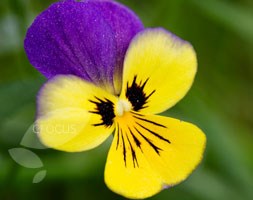
Viola tricolor (heartsease) £1.99
Position: full sun or partial shade Soil: any well-drained soil Rate of growth: average Flowering period: April to September Flower colour: purple, lavender-blue, white or yellow with dark purple upper petals Hardiness: hardy annual Dainty, small-headed pansies in shades of purple, violet, cream and yellow, appear in profusion for a long period throughout the summer. The flowers of this annual or short-lived perennial are edible and can be used to garnish puddings or add to salads. Perfect plant for the woodland garden, they also make very pretty addition to posies. If the flowers are left on the plant they will self-seed freely, otherwise pick them regularly to encourage more to form. Garden care: Early sowings can be done in a cold frame, into trays of good seed compost and gradually hardened off before planting out. Alternatively sow directly into a well-prepared seed bed. Gently thin the seedlings out to 15cm apart when they are large enough to handle. Sow: March – May or August – September Flowering: May – October Approximate quantity: 75 seeds.
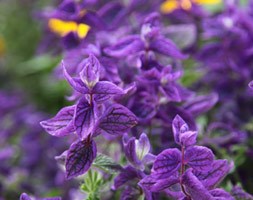
Salvia viridis ‘Blue’ (annual clary) £1.99
Position: full sun or partial shade Soil: moderately fertile, humus-rich, well-drained soil Rate of growth: average to fast-growing Flowering period: May to August Flowering colour: deep blue bracts Hardiness: fully hardy An easy and vigorous annual that produces spires of small flowers, which are encased in very showy, clearly-veined, rich blue bracts. These make excellent and long-lasting cut flowers and will also hold their colour well when dried and added to more permanent displays inside the house. Garden care: Under glass, sow the seeds shallowly in seed trays filled with good seed compost and keep at 16-18C. When the seedlings are large enough to handle, thin them out and pot on individually into small pots to grow on. Gradually harden them off before planting out at 25cm intervals in a sunny, well-prepared bed. When watering, it is best to give the plants a really thorough soak when the soil gets dry, rather than applying a little water every day. Sow: March-May Flowering: June-August Approximate quantity: 180 seeds.
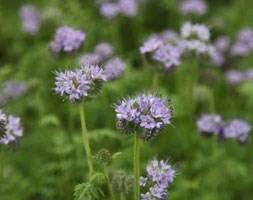
Phacelia tanacetifolia (fiddleneck) £1.79
Position: full sun Soil: any, fertile, well-drained soil Rate of growth: average to fast-growing Flowering period: June to September Flower colour: lavender-blue Other features: contact with the foliage may aggravate skin allergies Hardiness: hardy annual Lavender-blue, bell-shaped flowers, which are laden with nectar, form in densely-packed clusters on sturdy stems and attract bees and other beneficial insects in their droves. Perfect for wildflower meadows, or naturalised planting schemes, the flowers will last well after being cut. The fast growing foliage will help suppress weeds and makes an attractive groundcover. Scorpion weed can also be treated as a green manure crop, which will help enrich the soil. They self-seed freely. Garden care: From early spring, sow into small pots filled with good seed compost and initially protect with a cold frame or unheated greenhouse. Pinch out the growing tips to encourage bushier growth and harden off before planting out. Alternatively sow direct in autumn into a sunny, well-prepared seed bed. Easy to grow, if you do not want the plants to set seed, remove the spent flowers as they fade. Sow: March-May or September-October Flowering: June-September Approximate quantity: 25 seeds.
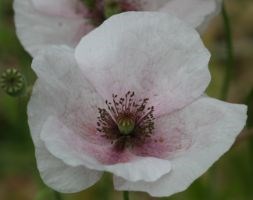
Papaver rhoeas ‘Fairy Wings’ (mixed) (field poppy) £1.49
Position: full sun Soil: well-drained, preferably poor soil Rate of growth: average Flowering period: June to August Hardiness: hardy annual An array of pink, white and lilac shades, which all have metallic-blue undertones, the flowers of this field poppy appear like luminous butterflies on top of the slender, hairy stems. Long after the last petal has fluttered away on the breeze, the seed-heads will continue to add a decorative touch to the border. Garden care: They tend to resent root disturbance, so sow shallowly, directly into a well prepared bed in spring and water well. As the seedlings develop, thin them out to 30cm intervals keeping just the healthiest and most robust plants. When watering, give the plants a really thorough soak when the soil gets dry, rather than a little water every day. Dead-heading will prolong the flowering period, but at the end of the season you should let some seed heads to develop for next years crop. Sow: March-May Flowering: June-August Approximate quantity: 1000 seeds.
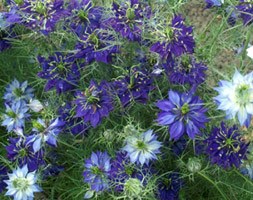
Nigella damascena ‘Oxford Blue’ (love-in-a-mist) £1.99
Position: full sun Soil: any well-drained soil Rate of growth: fast growing Flowering period: July to September Flower colour: deep blue Other features: excellent cut and dried flowers Hardiness: fully hardy Throughout summer extra-large, deep blue flowers appear amid the decorative, finely-cut foliage. This tall love-in-a-mist is perfect for a sunny, well-drained cottage-garden border or wildflower meadow. It is extremely easy-to-grow, and the dried seed-heads are valuable for use in winter flower arrangements. Garden care: Best sown in situ, 5mm deep. Prepare the seedbed by incorporating some composted organic matter, remove any stones and rake to a fine tilth. Sow in autumn if you want early flowers the following summer, or in mid spring for a later crop. Thin them out when they are large enough to handle allowing 30cm between each. Deadheading regularly will help prolong the flowering period into autumn. Support the plants with twiggy branches in exposed gardens. Sow: September-October or March-May Flowering: June-September Approximate quantity: 500 seeds.
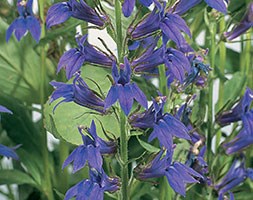
Lobelia x speciosa ‘Fan Blau’ (Fan Series) (lobelia) £1.49
Position: full sun or partial shade Soil: deep, fertile, moist soil Rate of growth: average Flowering period: June to October Flower colour: violet-blue Other features: contact with the sap may cause skin irritation Hardiness: fully hardy Densely packed racemes hover above leafy basal rosettes, opening upwards from their base to two-lipped flowers, which are a vibrant shade of violet-blue. Appearing over a long period, they offer a superb contrast to many shades of pink, plum and purple. Garden care: Divide large clumps of plants every second year in spring. Protect the crown of the plant during winter with a thick, dry mulch, such as straw.
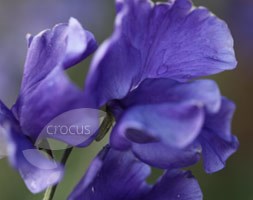
Lathyrus odoratus ‘Oxford Blue’ (spencer sweet pea seed Oxford Blue) £1.99
Position: full sun Soil: fertile, humus-rich, well-drained soil Rate of growth: average to fast-growing Flowering period: June to September Flower colour: purple-blue Other features: well scented flowers Hardiness: hardy annual The colour of these fragrant blue blooms intensifies as they age, providing a very pretty contrast to the greyish-green leaves. Sweet peas are a cottage garden favourite and look wonderful when allowed to scramble over a wigwam of brushwood where they will get sun for the best part of the day. In our (not very scientific) sweet pea trial on the nursery, we found that the flowers of this variety had a slight fragrance and were held on 6 – 8″ stems. There were not too many left in August though. All the sweet-peas in our trial produced significantly better plants when the seeds were sown in autumn rather than spring. Garden care: From October to late February, sow seeds into deep pots or root trainers filled with a good-quality seed compost and place them in a cold frame. Pinch out the tips as the plants grow to encourage them to become bushier and produce more flowers, and harden off before planting out in early April. Direct sowings can also be made in October or March. It is important to remove the faded flowers before they set seed, so picking them to fill a vase inside will only encourage more to form. Sow: October-February or April Flowering: June-September Approximate quantity: 20 seeds.
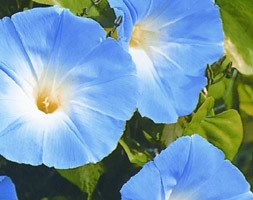
Ipomoea tricolor ‘Heavenly Blue’ (morning glory) £1.49
Position: full sun Soil: moderately fertile, well-drained soil Rate of growth: average Flowering period: June to August Flower colour: sky-blue Other features: mid-green leaves; the seeds are highly toxic if ingested Hardiness: tender Vibrant, azure-blue, trumpet-shaped flowers, each with a white eye, open in the morning and last just one day, but appear in a continuous stream throughout the summer. This is a spectacular annual or short-lived perennial climber, that is ideal for training over a pergola or arch in a sunny, sheltered site. Garden care: Soak the seeds in water for 24 hours before sowing to soften them up and then plant 2.5mm deep into small pots filled with a freely draining compost. Keep them at around 20C and water when necessary. Thin out carefully when large enough to handle taking care not to damage the roots and harden off before planting out after all frosts. Sow: March-May Flowering: June-September Approximate quantity: 85 seeds.
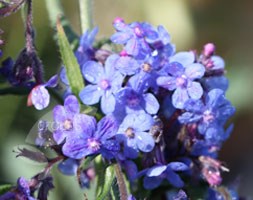
Anchusa azurea ‘Dropmore’ (alkanet) £1.49
Position: full sun Soil: fertile, moist, well-drained soil Rate of Growth: average Flowering period: June to August Flowers: deep blue Other features: the flowers are highly attractive to bees and other beneficial insects Hardiness: fully hardy Vibrant, deep blue flowers appear on upright stems throughout the summer creating a dazzling display. Their edible petals look wonderful sprinkled into salads or frozen into ice cubes and then plonked into summer drinks. The flowers are also suitable for drying and make colourful additions to pot-pourri. Alkanet makes a great companion to rich plums and purple tones and will thrive in a sunny border. Although short lived the plant can self-seed freely. The flowers are loved by bees and butterflies so they make wonderful additions to the wildlife garden. Garden care: Surface sow the seeds onto the top of seed trays filled with good seed compost, pressing them in gently before watering well. Keep warm under glass until germination (usually 3 – 4 weeks later) and pot on when large enough to handle. Gradually acclimatise before planting out after frost. Late sowing can be done direct into a well-prepared bed outside. Sow: February – June Flowering: June – August Approximate quantity: 60 seeds.
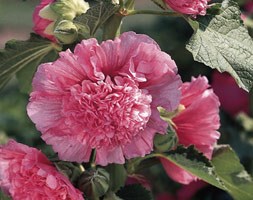
Alcea rosea Chater’s Double Group rose pink-flowered (hollyhock) £1.49
Position: full sun Soil: moderately-fertile, well-drained soil Rate of growth: fast-growing Flowering period: June to August Hardiness: fully hardy Slender spires of rose pink, pompom-like flowers, look wonderful when planted with a wide range of pastel shades or stronger blues, purples and plum. Their architectural structure will form a wonderful backdrop for lower-growing perennials. Garden care: Water well during dry spells. In autumn cut the plants back to 15cm (6in) from the ground.






